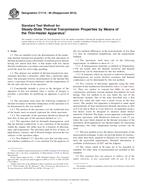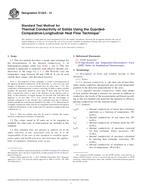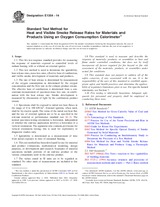Potrebujeme váš súhlas na využitie jednotlivých dát, aby sa vám okrem iného mohli ukazovať informácie týkajúce sa vašich záujmov. Súhlas udelíte kliknutím na tlačidlo „OK“.
ASTM C1114-06(2013)
Standard Test Method for Steady-State Thermal Transmission Properties by Means of the Thin-Heater Apparatus
Automaticky preložený názov:
Štandardná skúšobná metóda pre ustálenej vlastnosti prestupu tepla pomocou Thin ohrievač Prístroje
NORMA vydaná dňa 1.9.2013
Informácie o norme:
Označenie normy: ASTM C1114-06(2013)
Poznámka: NEPLATNÁ
Dátum vydania normy: 1.9.2013
Kód tovaru: NS-9560
Počet strán: 10
Približná hmotnosť: 30 g (0.07 libier)
Krajina: Americká technická norma
Kategória: Technické normy ASTM
Kategórie - podobné normy:
Anotácia textu normy ASTM C1114-06(2013) :
Keywords:
heat flow, thermal conductivity, thermal resistivity, thermal transmission, thin-heater apparatus, unguarded hot plate, ICS Number Code 17.200.10 (Heat. Calorimetry)
Doplňujúce informácie
| Significance and Use | ||||||||||||||||||
|
5.1 Factors that may influence the thermal-transmission properties of a specimen of material are described in Practice C1045 and the Precision and Bias section of Test Method C177. 5.2 Because of the required test conditions prescribed by this test method, it shall be recognized that the thermal properties obtained will not necessarily apply without modification to all conditions of service. As an example, this test method normally provides that the thermal properties shall be obtained on specimens that do not contain moisture, although in service such conditions may not be realized. Even more basic is the dependence of the thermal properties on variables such as mean temperature and temperature difference. 5.3 When a new or modified design of apparatus is evolved, tests shall be made on at least two sets of differing material of known long-term thermal stability. Tests shall be made for each material at a minimum of two different mean temperatures within the operating range of each. Any differences in results should be carefully studied to determine the cause and then be removed by appropriate action. Only after a successful verification study on materials having known thermal properties traceable to a recognized national standards laboratory shall test results obtained with this apparatus be considered to conform with this test method. Periodic checks of apparatus performance are recommended. 5.4 The thermal transmission properties of many materials depend upon the prior thermal history. Care must be exercised when testing such specimens at a number of conditions so that tests are performed in a sequence that limits such effects on the results. 5.5 Typical uses for the thin-heater apparatus include the following: 5.5.1 Product development and quality control applications. 5.5.2 Measurement of thermal conductivity at desired mean temperatures. 5.5.3 Thermal properties of specimens that are moist or close to melting point or other critical temperature (see Note 1). 5.5.4 Determination of thermal
properties of relatively high R value insulation
samples with large apparatuses. In the case of the metal-screen
heater apparatus, samples with thicknesses up to 15 cm can be
measured.
|
||||||||||||||||||
| 1. Scope | ||||||||||||||||||
|
1.1 This test method covers the determination of the steady-state thermal transmission properties of flat-slab specimens of thermal insulation using a thin heater of uniform power density having low lateral heat flow. A thin heater with low lateral thermal conductance can reduce unwanted lateral heat flow and avoid the need for active-edge guarding. 1.2 This primary test method of thermal-transmission measurement describes a principle, rather than a particular apparatus. The principle involves determination of the thermal flux across a specimen of known thickness and the temperatures of the hot and cold faces of the specimen. 1.3 Considerable latitude is given to the designer of the apparatus in this test method; since a variety of designs is possible, a procedure for qualifying an apparatus is given in 5.3. 1.4 The specimens must meet the following conditions if thermal resistance or thermal conductance of the specimen is to be determined by this test method2: 1.4.1 The portion of the specimen over the isothermal area of the heater must accurately represent the whole specimen. 1.4.2 The remainder of the specimen should not distort the heat flow in that part of the specimen defined in 1.4.3 The specimen shall be thermally homogeneous such that the thermal conductivity is not a function of the position within the sample, but rather may be a function of direction, time, and temperature. The specimen shall be free of holes, of high-density volumes, and of thermal bridges between the test surfaces or the specimen edges. 1.4.4 Test Method C177 describes tests that can help ascertain whether conditions of 1.4 are satisfied. For the purposes of this test method, differences in the measurements of less than 2 % may be considered insignificant, and the requirements fulfilled. 1.5 The specimens shall meet one of the following requirements, in addition to those of 1.4. 1.5.1 If homogeneous materials as defined in Terminology C168 are tested, then the thermal resistivity and thermal conductivity can be determined by this test method. 1.5.2 If materials which are layered or otherwise thermally inhomogeneous are tested, thermal resistance and thermal conductance can be determined by this test method. 1.6 Two versions of thin-heater apparatus using the same principle of the standard are described in 1.7 This test method covers the theory and principles of the measurement technique. It does not provide details of construction other than those required to illustrate two devices which meet the prescribed requirements. Detailed information is available in References (1-23)3 and the Adjunct. 1.8 The values stated in SI units are to be regarded as standard. No other units of measurement are included in this standard. 1.9 This standard does not purport to address all of the safety concerns, if any, associated with its use. It is the responsibility of the user of this standard to establish appropriate safety and health practices and determine the applicability of regulatory limitations prior to use. |
||||||||||||||||||
| 2. Referenced Documents | ||||||||||||||||||
|
Podobné normy:
Historická
1.1.2010
Historická
1.4.2014
Historická
1.10.2013
Historická
1.4.2011
Historická
1.5.2014
Historická
15.3.2014



 ASTM D7314-10
ASTM D7314-10 ASTM E1142-14a
ASTM E1142-14a ASTM E1225-13
ASTM E1225-13 ASTM E1269-11
ASTM E1269-11 ASTM E1354-14
ASTM E1354-14 ASTM E1356-08(2014)..
ASTM E1356-08(2014)..
 Cookies
Cookies
